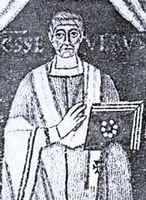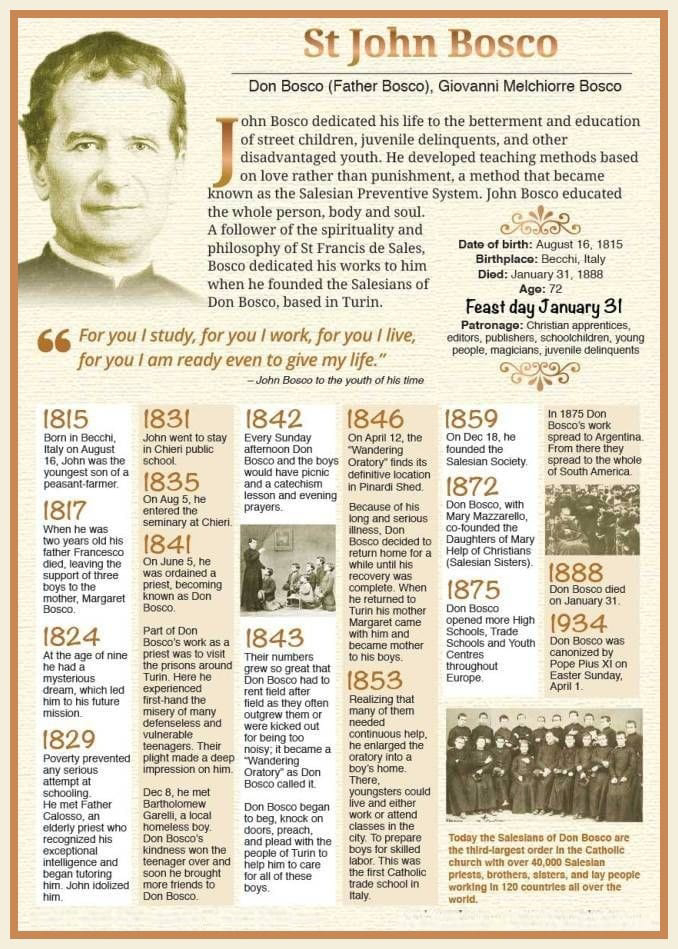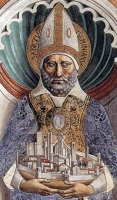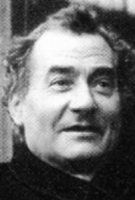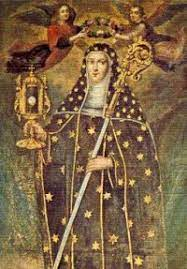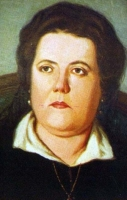Saint Brigid of Ireland
அயர்லாந்து புனிதர் பிரிஜிட்
கன்னியர், பெண் துறவியர் மடாதிபதி, ஊக்கமளிப்பவர்:
(Virgin, Abbess, Inspirer)
பிறப்பு: கி.பி. 453
ஃபௌகார்ட், டுண்டால்க், அயர்லாந்து
(Faughart, Dundalk, Ireland)
இறப்பு: ஃபிப்ரவரி 524 (வயது சுமார் 70)
கில்டேர், அயர்லாந்து
(Kildare, Ireland)
ஏற்கும் சமயம்:
ரோமன் கத்தோலிக்க திருச்சபை
(Roman Catholic Church)
கிழக்கு மரபுவழி திருச்சபை
(Eastern Orthodox Church)
ஆங்கிலிக்கன் சமூகம்
(Anglican Communion)
நினைவுத் திருவிழா: ஃபெப்ரவரி 1
பாதுகாவல்:
குழந்தைகள், கொல்லன், படகோட்டிகள், குடிபான உற்பத்தியாளர், கால்நடைகள், கோழி வளர்ப்போர், திருமணம் செய்யாத பெற்றோரின் குழந்தைகள், தவறான தந்தைக்கு பிறந்த குழந்தைகள், தவறான சமூகத்தில் பிறந்த குழந்தைகள், பால் பண்ணை வேலைக்காரிகள், பால் பண்ணை தொழிலாளர்கள், தப்பியோடியவர்கள், கைக்குழந்தைகள், அயர்லாந்து, கப்பற்படை வீரர்கள், தாதிகள், துறவிகள், கவிஞர்கள், ஏழை, கோழி விவசாயிகள், அச்சகங்களின் பணியாளர்கள், மாலுமிகள், அறிஞர்கள், பயணிகள்
அயர்லாந்து புனிதர் பிரிஜிட், அயர்லாந்தின் பாதுகாவலர்களுள் ஒருவர் ஆவார். புனிதர் பேட்ரிக் (St. Patrick) மற்றும் புனிதர் கொலம்பியா (St. Columba) ஆகியோரும் அயர்லாந்தின் புனிதர்கள் ஆவர். புனிதர்களைப் பற்றிய சரித்திரங்களை எழுதும் ஐரிஷ் அமைப்பு, (Irish Hagiography) இவரை ஆதி கிறிஸ்தவ துறவி என்றும், பெண் துறவியர் மடாதிபதி என்றும், பல்வேறு பெண் துறவியர்க்கான மடங்களை நிறுவியவர் என்றும், பிரபலமாக மதிக்கப்படும் "அயர்லாந்தின் கில்டேர்" (Kildare in Ireland) துறவு மடம் உள்ளிட்ட பல்வேறு பெண் துறவியர் மடங்களை நிறுவியவர் என்றும் கூறுகிறது.
பிரிஜிட் நிஜமாகவே ஒரு மனிதர்தானா என்ற விவாதமும் உண்டு. பிரிஜிட் எனும் "செல்டிக்" பெண் தெய்வத்துக்கும் (Celtic Goddess Brigid) இவருக்குமுள்ள பெயர், நினைவுத் திருநாள் தினம், இயற்கை நிகழ்வுகள், புனைவுகள் மற்றும் அவரது தொடர்புடைய நாட்டுப்புறப் பண்பாடுகள் ஆகியன இருவரும் ஒருவர்தானா என்ற விவாதத்தை எப்போதுமே முன்னிறுத்துகின்றன.
இவர், வெறுமனே கிறிஸ்தவமயமாக்கலின் பெண் தெய்வம் ஆவார் என்றும் சில அறிஞர்கள் சொல்கிறார்கள். வேறு சில அறிஞர்களோ, அவர் செல்டிக் பெண் தெய்வத்தின் பண்புகளைக் கொண்ட சாதாரண பெண்தான் என்றும் கூறுகின்றனர்.
பிரிஜிட், கி.பி. 451ம் ஆண்டு, அயர்லாந்தில் (Ireland) உள்ள “டுண்டால்க்” (Dundalk) எனுமிடத்தின் வடக்கேயுள்ள “ஃபௌகார்ட்” (Faughart) எனும் இடத்தில் பிறந்தவர் ஆவார். அவரது வாழ்க்கையின் நம்பகத்தன்மையைப் பற்றின ஏற்கனவே இருந்த பழம்பெரும் தரமான மாறுபட்ட மற்றும் முரண்பாடு கொண்ட வரலாறு காரணமாக மதச் சார்பற்ற மற்றும் கிறிஸ்தவ அறிஞர்களிடையே எப்போதுமே விவாதங்கள் நிகழ்ந்து வந்துள்ளன.
இவரது மூன்று வாழ்க்கை வரலாறுகள், இவரது தாயார் பெயர் "ப்ரோக்கா" (Brocca) என்றும் ஒரு அடிமை என்றும் ஒரு கிறிஸ்தவ 'பிக்ட்' (Christian Pict) (ரோமானிய காலங்களில் வடக்கு ஸ்காட்லாந்தின் கைக்கொள்ளும் ஒரு பண்டைய மக்கள் ஒரு உறுப்பினரை "பிக்ட்" என்பர்) என்றும் புனித பேட்ரிக் (Saint Patrick) அவர்களால் திருமுழுக்கு பெற்றவர் என்றும் கூறுகின்றன. அதே வரலாறுகள், பிரிஜிட்டின் தந்தை பெயர் "டுப்தாச்" (Dubhthach) என்றும் அயர்லாந்தின் தென்கிழக்கு பிராந்தியமான "லேய்ன்ஸ்ட்டர்" (Leinster) பகுதியின் தலைவராக இருந்தவர் என்றும் கூறுகின்றன.
அடிமையான "ப்ரோக்கா" கர்ப்பமானபோது, அவரை ஒரு பாதிரியிடம் விற்று விடுமாறு, "டுப்தாச்சின்" (Dubhthach) மனைவி அவரை வற்புறுத்தியதாக சரித்திரம் கூறுகிறது. இதனால், பிரிஜிட் தாமே ஒரு அடிமைத்தளையிலேயே பிறந்தார். ஆரம்பத்திலிருந்தே பிரிஜிட் பரிசுத்தமானவராக இருந்தார். அவரை வாங்கிய பாதிரி அவருக்கு உணவு கொடுக்க முயலும்போதெல்லாம் அவர் பாதிரியின் அசுத்தம் காரணமாக வாந்தி எடுத்தார் என்பர். ஆனால், அப்போதெல்லாம் செந்நிற காதுகளைக் கொண்ட ஒரு வெண்ணிற பசு வந்து அதிசயமாக அவரை இரட்சித்தது என்பர். அவர் வளர்கையிலேயே பல அதிசயங்களை நிகழ்த்தினார். நோயுற்றோரின் நோய் நீக்கினார். ஏழைகளுக்கு உணவிட்டார். ஒருமுறை, தமது தாய் வைத்திருந்த வெண்ணெய் முழுதும் எடுத்து அவர் ஏழைகளுக்கு கொடுத்தார். ஆனால், அவரது செபத்தின் பயனாக, காலி செய்யப்பட்ட வெண்ணெய் மீண்டும் நிரப்பப்பட்டதாக கூறுகிறார்கள்.
பத்து வயதான பிரிஜிட், ஒரு வீட்டு வேலைக்கார பெண்ணாக தமது தந்தையின் வீட்டுக்கே சென்றார். அவரது தாராள தொண்டுள்ளமானது, இல்லையென்று கேட்பவர்களுக்கு தனது தந்தையின் பொருட்களை வழங்கினார்.
இரட்டை வாழ்க்கை வாழ்ந்த "டுப்தாச்" (Dubhthach) பிரிஜிட்டின் செயல்களால் கோபமுற்றார். அவரை “லெய்ன்ஸ்டர்” (King of Leinster) அரசனிடம் விற்பதற்காக ஒரு வண்டியில் அழைத்துச் சென்றார். அவர் அரசனுடன் பேசிக்கொண்டிருந்த வேளையில், தமது தந்தையின் பொற்பிடியிட்ட வாளை எடுத்து, ஒரு பிச்சைக்காரனிடம் கொடுத்து அதை அவனது குடும்பத்தின் உணவுக்காக மாற்றிக்கொள்ள சொன்னார். அவரது புனிதத் தன்மையை கண்டுகொண்ட அரசன், அவரை விடுவிக்குமாறு அவரது தந்தையை அறிவுறுத்தினார்.
சுமார் 480ம் ஆண்டு, பிரிஜிட் தமது ஏழு உதவியாளர் பெண்களுடன் இணைந்து கில்டேர் நகரில் ஒரு துறவு மடத்தினை நிறுவினார். அது, அங்கே அவர்களால் ஒரு நித்திய சுடர் எரிய காரணமானது. அயர்லாந்து பெண்களுக்கு ஒரு சமூக - மத வாழ்வினை பிரதிஷ்டை செய்தார். அவர் ஆண்களுக்கான ஒரு துறவு மடமும், பெண்களுக்கான ஒரு துறவு மடமும் நிறுவினார். பிரிஜிட்டின் சிறு வாக்குவன்மை, கில்டேர் நகரை ஒரு ஆன்மிகம் மற்றும் கற்பதற்கான ஒரு மையமாக மாற்றியது. அத்துடன் ஒரு ஆலயங்களின் நகராக உருவெடுத்தது. அவர், உலோக வேலைகள் மற்றும் ஒளியமைக்கும் பணிகள் உள்ளிட்ட கலைப் பள்ளியொன்றையும் நிறுவி நடத்தினார்.
ஏழாம் நூற்றாண்டி வாழ்ந்த பண்டைய அயர்லாந்தின் “அர்ட்ப்ரக்கன்” மறைமாவட்ட (Bishop of Ardbraccan) ஆயரும், மடாதிபதியும், ஐரிஷ் புனிதருமான “உல்ட்டான்” (St. Ultan of Ardbraccan) பிரிஜிட்டின் சரிதத்தை எழுதுகையில், பிரிஜிட் மிகவும் விரும்பிய அவரது மாணவியும், அவருக்குப் பிறகு அவரது மடத்திற்கு மடாதிபதியான “டர் லுக்டச்” (Dar Lugdach) ஒரு இளைஞனுடன் காதலில் விழுந்தாராம். அவ்விளைஞனை இரவில் சந்திக்க விரும்பிய அவர், பிரிஜிட்டுடன் ஒன்றாக படுத்திருந்த படுக்கையில் இருந்து எழுந்தே வெளியே சென்றார். எனினும், தமது ஆவிக்குரிய ஆபத்தை உணர்ந்த அவர், வழிநடத்துதலுக்காக பிரார்த்தனை செய்தார். பின்னர் அவளது காலணிகளில் நீரு பூத்த நெருப்பு வைத்து, அதனை அணிந்துகொண்டார். அவள் வைத்த தீயை அவளே அணைத்தாள். வலியே அவளது வலியை அணைத்தது. பின்னர் அவள் படுக்கைக்கு திரும்பினாள். உறங்குவது போலிருந்த பிரிஜிட், “டர் லுக்டச்” (Dar Lugdach) படுக்கையை விட்டு எழுந்து சென்றதை அறிந்திருந்தார். மறுநாள், தமக்கு நேர்ந்ததை பிரிஜிட்டிடம் “டர் லுக்டச்” கூறினார். ஆசைகளால் ஏற்பட்ட உணர்ச்சித் தீயிலிருந்தும், பின்னால் ஏற்படவிருந்த நரகத் தீயிலிருந்தும் தப்பிவிட்டதாக கூறிய பிரிஜிட், தமது மாணவியின் கால்களிலிருந்த புண்களை குணப்படுத்தினார். இதனால் தமது ஆசிரியை மீது மிக உயர்ந்த அன்பு கொண்ட மாணவி, பிரிஜிட் மரண படுக்கையில் இருந்தபோது, தாமும் அவருடன் மரிக்க விரும்புவதாக கூறினார். இதனை தடுத்த பிரிஜிட், இப்போதல்ல, ஆனால் என்னுடைய மரணத்தின் ஆண்டு நிறைவின்போது அது நிறைவேறும் என்றார்.
பிரிஜிட் மரண படுக்கையில் இருந்தபோது, அவருக்கு இறுதி திருவருட்சாதனங்களை புனிதர் “நின்னித்” (St Ninnidh) அளித்தார். அதன் பின்னர், அவருக்கு அவருக்கு இறுதி திருவருட்சாதனங்களளித்த தமது வலது கரம் மாசு படலாகாது எனும் காரணத்தால் தமது வலது கரத்தை உலோக உரையால் மூடிக்கொண்டார். இதனால் அவர், “சுத்தமான கரங்களின் நிம்மித்” (Ninnidh of the Clean Hand) என்றழைக்கப்பட்டார்.
கி.பி. 525ம் ஆண்டு, ஃபெப்ரவரி மாதம், முதல் தேதியன்று பிரிஜிட் மரித்ததாக மரபுகள் கூறுகின்றன. அவருக்குப் பிறகு, அவரது மாணவியான “டர் லுக்டச்” அவரது மடத்துக்கு தலைவரானார். பிரிஜிட் கி.பி. 521ம் ஆண்டு மரித்ததாகவும், அவர் கணித்ததுபோலவே அவரது மாணவியான “டர் லுக்டச்” கி.பி. 522ம் ஆண்டு, ஃபெப்ரவரி மாதம் முதல் நாள் மரித்ததாகவும் கத்தோலிக்க திருச்சபை கூறுகிறது.
Also known as
• Brigid of Kildare
• Brigid of Cell Dara
• Brigid of the Isles
• Mary of the Gael
• Bride, Bridget, Brigit, Ffraid
Additional Memorial
10 June (translation of relics)
Profile
Daughter of Dubtach, pagan Scottish king of Leinster, and Brocca, a Christian Pictish slave who had been baptized by Saint Patrick. Just before Brigid's birth, her mother was sold to a Druid landowner. Brigid remained with her mother till she was old enough to serve her legal owner Dubtach, her father.
She grew up marked by her high spirits and tender heart, and as a child, she heard Saint Patrick preach, which she never forgot. She could not bear to see anyone hungry or cold, and to help them, often gave away things that were Dubtach's. When Dubtach protested, she replied that "Christ dwelt in every creature". Dubtach tried to sell her to the King of Leinster, and while they bargained, she gave a treasured sword of her father's to a leper. Dubtach was about to strike her when Brigid explained she had given the sword to God through the leper, because of its great value. The King, a Christian, forbade Dubtach to strike her, saying "Her merit before God is greater than ours". Dubtach solved this domestic problem by giving Brigid her freedom.
Brigid's aged mother was in charge of her master's dairy. Brigid took charge ,and often gave away the produce. But the dairy prospered under her (hence her patronage of milk maids, dairy workers, cattle, etc.), and the Druid freed Brigid's mother.
Brigid returned to her father, who arranged a marriage for her with a young bard. Bride refused, and to keep her virginity, went to her Bishop, Saint Mel of Ardagh, and took her first vows. Legend says that she prayed that her beauty be taken from her so no one would seek her hand in marriage; her prayer was granted, and she regained her beauty only after making her vows. Another tale says that when Saint Patrick heard her final vows, he mistakenly used the form for ordaining priests. When told of it he replied, "So be it, my son, she is destined for great things."
Her first convent started c.468 with seven nuns. At the invitation of bishops, she started convents all over Ireland. She was a great traveller, especially considering the conditions of the time, which led to her patronage of travellers, sailors, etc. Brigid invented the double monastery, the monastery of Kildara, which means Church of the Oak, that she ran on the Liffey river being for both monks and nuns. Saint Conleth became its first bishop; this connection and the installation of a bell that lasted over 1000 years apparently led to her patronage of blacksmiths and those in related fields.
Born
453 at Faughart, County Louth, Ireland
Died
• 1 February 523 at Kildare, Ireland of natural causes
• interred in the Kildare cathedral
• relics transferred to Downpatrick, Ireland in 878 where they were interred with those of Saint Patrick and Saint Columba of Iona
• relics re-discovered on 9 June 1185
• head removed to Jesuit church in Lisbon, Portugal
Name Meaning
fiery arrow (= brigid)
Patronage
• babies
• blacksmiths
• boatmen
• cattle
• chicken farmers
• children whose parents are not married
• dairymaids
• dairy workers
• fugitives
• infants
• Ireland
• mariners
• midwives
• milk maids
• newborn babies
• nuns
• poets
• poultry
• poultry farmers
• poultry raisers
• printing presses
• sailors
• scholars
• travellers
• watermen
• Douglas, Lanarkshire, Scotland
• Ivrea, Turin, Italy
• Leinster, Ireland
• Kildare, Ireland, diocese of
Saint Tryphon of Lampsacus
புனித_ட்ரைபோன் (222-251)
பிப்ரவரி 01
இவர் (#StTryphonOfLampsacus) பிரிகியாவில், அதாவது தற்போதைய துருக்கியில் பிறந்தவர்.
இவர் சிறுவயது முதலே இறைவன்மீது ஆழமான நம்பிக்கைகொண்டிருந்தார். எல்லாம் நன்றாகச் சென்று கொண்டிருந்த வேளையில் இவரது தந்தை திடீரென இறந்துபோனார். இதனால் இவர் தன் தாய் யூகாரியாவின் பராமரிப்பில் வளர்ந்து வந்தார்.
தன் தாய்க்கு உதவியாக வாத்துகளை மேய்த்து வந்த இவர், நோயுற்றிருந்தவர்களை நலப்படுத்தும் ஆற்றலைப் பெற்றிருந்தார். ஒருமுறை மூன்றாம் கோர்தியன் என்ற மன்னனின் மகள் தீயஆவி பிடித்து அலைக்கழிக்கப் பட்டபோது, இவர் அவருக்காக வேண்ட, அவரிடமிருந்து தீய ஆவி வெளியேறியது.
இன்னொரு முறை வெட்டுக் கிளிகளால் விவசாயிகள் மிகுந்த பாதிப்புக்கு உள்ளான போது, இவருடைய வேண்டுதலால் வெட்டுக்கிளிகள் ஒழிந்தன.
இவர் இறைவார்த்தையை மிகுந்த வல்லமையோடு மக்களுக்குப் போதித்துப் பலரையும் கிறிஸ்துவின்மீது நம்பிக்கை கொள்ளச் செய்தார். இதனால் 251 ஆம் ஆண்டு தேசியூஸ் என்ற மன்னன் இவரைத் தலைவெட்டிக் கொன்று போட்டான்.
Also known as
• Tryphon of Camposede
• Tryphon of Campsada
• Tryphon of Kampsade
• Tryphon of Lampsakos
• Tryphon of Phrygia
• Tryphon the Martyr
• Trypho, Trifon, Trifone
Additional Memorials
• 10 November (translation of relics)
• 13 January (translation of relics)
Profile
Raised in a Christian family, his father died when the boy was very young, he was raised by his mother Eukaria, and he worked as a goose-herd in his youth. Had a gift of healing both human and animals. Healed the demonic possession of the daughter of Emperor Gordian III; the demon appeared in the form of a black dog before being forced to admit his deeds and then vanishing. Tryphon's prayers turned away a swarm of locusts that threatened his village's grain harvest. A persuasive speaker and catechist, he brought many to the faith, including pagan imperial officials. Arrested, tortured and martyred in the persecutions of Decius.
Born
c.222 at Kampsade, Phrygia (in modern Turkey)
Died
• beheaded c.251 in Nicaea, Bithynia, Asia Minor (modern Iznik, Turkey)
• buried in Kampsade, Phrygia
• relics transferred to Constantinople
• relics transferred to Venice, Italy in 809; en route, bad weather forced the transport ship aground at modern Kotor, Montenegro where the relics were housed in the local cathedral
• relics transferred to Rome, Italy where they were housed in the church of San Trifon and the Santo Spirito hospital in Sassi
• in 1566 Pope Pius V transferred the relics to the church of Sant'Agostino in Rome
• some relics enshrined in the Saint Triphon church in the Naprudna district of Moscow, Russia
Patronage
• against evil spirits
• against insects
• birds
• gardeners
• grain
• harvested crops
• husbandmen
• 8 cities
Blessed Luigi Variara
அருளாளர் லூய்கி வேரியரா
சலேசிய குரு & நிறுவனர்:
(Priest of the Salesians & Founder)
பிறப்பு: ஜனவரி 15, 1875
வியரிகி, அஸ்தி, இத்தாலி இராச்சியம்
(Viarigi, Asti, Kingdom of Italy)
இறப்பு: ஃபெப்ரவரி 1, 1923 (வயது 48)
சான் ஜோஸ் டி குக்குடா, நோர்டே டி சாண்டாண்டர், கொலம்பியா
(San José de Cucuta, Norte de Santander, Colombia)
ஏற்கும் சமயம்:
ரோமன் கத்தோலிக்க திருச்சபை
(Roman Catholic Church)
முக்திப்பேறு பட்டம்: ஏப்ரல் 14, 2002
திருத்தந்தை இரண்டாம் ஜான் பால்
(Pope John Paul II)
நினைவுத் திருநாள்:
ஃபெப்ரவரி 1
ஜனவரி 15 (சலேசியா குருக்கள் - (Salesians)
பாதுகாவல்:
இயேசு மற்றும் மரியாவின் திருஇதய மகள்கள் சபை
(Congregation of Daughters of the Sacred Hearts of Jesus and Mary),
மிஷனரிகள்
அருளாளர் லூய்கி வேரியரா, ஒரு இத்தாலிய ரோமன் கத்தோலிக்க குரு ஆவார். இவர், புனிதர் தொன் போஸ்கோ (St. Don Bosco) நிறுவிய சலேசியன் (Salesians) சபையின் உறுப்பினருமாவார். அவர் தனது வாழ்க்கையின் பெரும்பகுதியை கொலம்பியா (Colombia) நாட்டில் மேற்கொண்ட பணிகளின் ஒரு பகுதியாக செலவிட்டார். அங்கு அவர் தொழுநோயாளிகளுடனும், கைவிடப்பட்ட தொழுநோயாளிகளின் குழந்தைகளுடனும் பணியாற்றினார். அவர் அங்கு பணியாற்றும்போது குருத்துவ அருட்பொழிவு பெற்றார். மேலும், தொழுநோயாளிகளுக்கு நிவாரணம் மற்றும் ஆறுதல் இரண்டையும் வழங்குவதே அவருடைய பிரதான பணியாக அமைந்தது.
தொழுநோயாளிகளுக்கும், அவர்களுடைய பிள்ளைகளுக்கும் மத வாழ்க்கையில் நுழைய வாய்ப்பளிக்கும் நோக்கத்துடன், அவர் "இயேசு மற்றும் மரியாவின் திருஇருதயங்களின் மகள்கள்" (Daughters of the Sacred Hearts of Jesus and Mary) சபையை நிறுவினார்.
திருத்தந்தை இரண்டாம் ஜான் பால் (Pope John Paul II) அவர்கள், 2002ம் ஆண்டு, ஏப்ரல் மாதம், 14ம் நாளன்று, வேரியராவை முக்திப்பேறு பட்டமளித்து, அருளாளர் நிலைக்கு உயர்த்தினார்.
லூய்கி வேரியரா, கி.பி. 1875ம் ஆண்டில், வடமேற்கு இத்தாலியின் (Northwestern Italy), "பியெட்மன்ட்" (Piedmont) பிராந்தியத்திலுள்ள, "ஆஸ்டி" (Asti) நகரில், "பியட்ரோ வேரியரா" () மற்றும் "லிவியா புஸ்ஸா" ஆகியோருக்குப் பிள்ளையாக பிறந்தார்.
இவர், தம்முடைய பன்னிரெண்டு வயதில், "டுரின்" (Turin) நகரிலுள்ள சலேசிய பள்ளியில் (Salesian Oratory) கல்வி கற்க இணைந்தார். கி.பி. 1856ம் ஆண்டு, தூய ஜான் போஸ்கோ (St. John Bosco) பிரசங்கிப்பதைக் கேள்விப்பட்ட இவரது தந்தை, இவருடைய கல்வியை நிறைவு செய்வதற்காக "வால்டோக்கோ" (Valdocco) நகருக்கு அழைத்துச் சென்றார். ஒரு சந்தர்ப்பத்தில் இந்த உயிருள்ள புனிதரைச் சந்திக்கும் பாக்கியத்தை லூய்கி பெற்றார். அது, அவரது வாழ்க்கையை மாற்றிய ஒரு சந்திப்பாக அமைந்ததுடன், அவரில் ஆழ்ந்த தாக்கத்தை விட்டுச்சென்றது. ஜான் போஸ்கோ அந்த சிறுவனின் கண்களை உற்றுப் பார்த்தார். இந்த பார்வை லூய்கிக்கு அவரது எதிர்கால சலேசிய பணிகளை உறுதிப்படுத்தியது. ஜான் போஸ்கோ, ஒரு மாதத்திற்குப் பிறகு, கி.பி. 1888ம் ஆண்டு, ஜனவரி மாதம், 31ம் தேதி, மரித்தார்.
1891ம் ஆண்டில், புதுமுகப் பயிற்சியில் (Novitiate) இணைந்த இவர், சிறிது காலத்திலேயே தனது பிரமாணங்களை தூய ஜான் போஸ்கோவின் முதல் வாரிசான அருளாளர் மைக்கேல் ருவாவின் கைகளில் செய்தார். தமது புதுமுகப் பயிற்சியின் பின்னர், "வால்சலிஸ்" (Valsalice) நகரில், தத்துவக் கல்வி பெற்றார். அங்கே, தம்முடைய பணிகள் பற்றி, தமது சலேசிய சமூகத்தினருடன் கலந்தாய்வு செய்ய வந்திருந்த கொலம்பியா நாட்டின் தொழுநோயாளிகளின் சலேசிய அப்போஸ்தலரான (Salesian Apostle of Lepers of Colombia) அருட்தந்தை மைக்கேல் யூனியாவைச் (Fr Michele Unia) சந்தித்தார். அவரது பேச்சு லூய்கியை வென்றது. கி.பி. 1894ம் ஆண்டு, அவர் திரும்பிச் சென்றபோது, அருட்தந்தை மைக்கேல் யூனியாவுடன் லூய்கியும் கொலம்பியாவுக்கு புறப்பட்டார்.
இங்கே அவர் "அகுவா டி டியோஸ்" (Agua de Dios) நகரின் தொழுநோயாளிகளுக்கு தன்னை அர்ப்பணித்தார். இசை மற்றும் நாடகம் மீதான தனது ஆர்வத்தை அவர்களுடன் பகிர்ந்து கொண்டார். லூய்கி மற்றும் மூன்று குருக்களை தொழுநோய் காலனிக்கு பொறுப்பாக்கிவிட்டு, அருட்தந்தை யுனியா சிறிது நேரத்திலேயே இறந்து போனார். அங்கே வசித்த சுமார் 2000 மக்களில், சுமார் 800க்கும் மேற்பட்டவர்கள் தொழு நோயால் பாத்திக்கப்பட்டிருந்தனர். அவர்களுக்கு சேவை செய்வதில் காலத்தை செலவிட்ட லூய்கி, கி.பி. 1898ம் ஆண்டு, கொலம்பியா நாட்டிலேயே குருத்துவ அருட்பொழிவு பெற்றார்.
சிறிது காலம், அங்குள்ள "மரியன்னையின் குழந்தைகளின் தோழமைக் கூட்டுறவு" (Sodality of the Children of Mary) எனும் அமைப்பின் ஆன்மீக இயக்குனராகவும் பணியாற்றினார். அவர் தினமும், பெரும்பாலும் ஒப்புறவு அளிப்பதில், சுமார் நான்கு முதல் ஐந்து மணி நேரம் பணியாற்றினார்.
1905ம் ஆண்டில், தாம் மிகுந்த அபிமானம் கொண்டிருந்த அருட்தந்தை யூனியாவுக்கு மரியாதை செலுத்தும் முகமாக, "தந்தை மைக்கேல் யூனியா மழலையர் பள்ளியை" (ather Michele Unia Kindergarten) நிறுவினார்.
தொழுநோயாளிகளும் - உண்மையில் தொழுநோயாளிகளின் பிள்ளைகளும் - மத வாழ்க்கையில் நுழைய முடியாது என்பதைப் உணர்ந்த அவர், ருவாவின் ஆலோசனையின்பேரில் ஒரு மத சபையை நிறுவ அனுமதிக்க முடிவு செய்தார். "போகோடா" (Archbishop of Bogotá) உயர்மறைமாவட்ட பேராயரின் அனுமதியுடனும், 1905ம் ஆண்டு, மே மாதம், 7ம் தேதி, இதை நிறுவ அனுமதித்ததற்கான முறையான ஒப்புதலுடனும் இதைச் செய்ய அவர் முடிவு செய்தார். இது, 1952ம் ஆண்டில் திருத்தந்தை பன்னிரெண்டாம் பயஸ் (Pope Pius XII) அவர்களிடமிருந்து பாராட்டுக்குரிய ஆணையைப் பெற்றது. 1964ம் ஆண்டு, ஏப்ரல் மாதம், 6ம் தேதி, திருத்தந்தை ஆறாம் பவுல் (Pope Paul VI) அவர்களிடமிருந்து முறையான அனுமதி கிட்டியது.
தொழுநோயாளிகள் தங்கள் வாழ்க்கையை கடவுளுக்கு அர்ப்பணிப்பதற்கான வாய்ப்பை தருவதற்காக சபை நிறுவப்பட்டதால், அருட்தந்தை லூய்கியின் முன்முயற்சி மற்ற மத சபைகளால் மிகவும் விமர்சிக்கப்பட்டதுடன், தவறாகவும் மதிப்பிடப்பட்டது.
எவ்வாறாயினும், லூய்கி கடவுளின் விருப்பத்தின்படி நடக்க உறுதியாக இருந்தார். மேலும் அவருக்கு மிக நெருக்கமாக இருக்க வேண்டியவர்களால் புரிந்துகொள்ளப்படாமலோ அல்லது ஏற்றுக்கொள்ளப்படாமலோ கல்வாரி ஏறத் தொடங்கினார். எவ்வாறாயினும், அவர் கீழ்ப்படிதலுக்கு புறம்பாக செயல்படுகிறார் என்பதை அறிந்தும், தொன் பாஸ்கோவின் முதல் வாரிசான அருட்தந்தை மைக்கேல் ருவா அவருக்குப் பின்னால் நின்று, அவருக்கு ஆறுதலையும் நிவாரணத்தையும் அளித்தார். லூய்கி உருவாக்கிய நிறுவனத்தை தொடர அவரை ஊக்குவித்தார்.
அவரது மிகப் பெரிய சோதனை, "அகுவா டி டையோஸ்" (Agua de Dios) நகரிலிருந்து, வெனிசுலாவுக்கு (Venezuela) அவர் மாற்றப்பட்டது என்பது நிரூபிக்கப்பட்டது. இது அவரது சபையிலிருந்து அவரை பிரித்தது. இது, அவருடைய சபையின்மீது மர்ம நிழலைத் தந்தது. மற்றும் லூய்கிக்கு 18 ஆண்டுகால தவறான புரிதல்களைத் தொடங்கியது. "அகுவா டி டையோஸ்" நகரை விட்டு வெளியேறிய பின்னர், அவர் ஒரு நகரத்திலிருந்து வேறொரு நகரத்திற்கு அடிக்கடி மாற்றப்பட்டார். மேலும் 1921ம் ஆண்டில் அவர் டெரிபாவுக்கு இறுதியாக மாற்றப்பட்டார். எவ்வாறாயினும், சபையின் இணை நிறுவனரான அன்னை லோசானோவுடன் (Mother Lozano) தொடர்ந்து தொடர்பு கொண்டிருந்தார். "பயப்பட ஒன்றுமில்லை - அது கடவுளின் பணி என்றால், அது நீடிக்கும்" என்று அவர் அன்னை லோசானோவுக்கு உறுதியளித்தார்.
லூய்கி வேரியரா 1923ம் ஆண்டு, ஃபெப்ரவரி மாதம், 1ம் தேதியன்று, தமது 48 வயதில் "குக்குட்டா" (Cucuta) நகரில் மரித்தார்.
Also known as
Aloisius Variara
Profile
Son of Peter Variara, who had been brought to a deep devotion to the Church following a mission conducted by Saint John Bosco. A student in a Salesian school, Luigi met John Bosco as a young man. The boy joined the Salesians in August 1891, making his vows in 1892.
In 1894 he joined a Salesian mission to leper colonies in Colombia. Ordained in Colombia. Founded a small town to raise the children of the outcast lepers. Spiritual director of the Sodality of the Children of Mary. Founded the Daughters of the Sacred Hearts of Jesus and Mary in Colombia in 1905, a congregation that included the daughters of lepers, girls who were drawn to religious life, but had trouble being accepted by other orders; it received official recognition on 24 December 1983.
After a brief visit to his family in home town, he returned to work in Bogota, Agua de Dios, and Caribbean Barranquilla. Toward the end of his life his health began to give way, and the only thing that kept him going were the hours he spent in Eucharistic devotion and prayer.
Born
15 January 1875 at Viarigi (Asti), Italy
Died
1 February 1923 in Colombia of natural causes
Beatified
14 April 2002 by Pope John Paul II
Blessed Reginald of Orléans
Also known as
• Réginald de Saint-Gilles
• Reginaldo...
Additional Memorial
12 February (Dominicans)
Profile
Priest. Professor of canon law at the Sorbonne in Paris, France. Dean of the collegiate church of Saint-Agnan in Orléans, France. While on pilgrimage in Rome, Italy in 1218, the future Pope Gregory IX introduced him to Saint Dominic de Guzman. Reginald was moved by Dominic‘s preaching, fascinated by some of his ideas, and the two became close friends. Following a vision of the Blessed Virgin Mary presenting him in a Dominican habit, and his miraculous cure from the vision, Reginald joined the Dominicans, receiving the habit from Saint Dominic. The two travelled to Bologna, Italy where Reginald impressed many with his preaching, and served as Dominican prior in the area when Dominic travelled on. Prior of the Dominican convent of Saint-Jacques in Paris in 1219 where he was known for his preaching, and where he led many to join the Order. Friend of Blessed Jordan of Saxony, who wrote about him and the fire of his preaching.
Born
c.1180 in Orléans, France
Died
• early February 1220 in Paris, France of natural causes
• buried in the Benedictine cemetery of Notre-Dame-des-Champs in Paris
Beatified
1875 by Pope Pius IX (cultus confirmation)
Blessed Benedict Daswa
Also known as
• Tshimangadzo Samuel Benedict Daswa
• Bakali
Profile
Married layman in the diocese of Tzaneen, South Africa. Member of the Lemba tribe, called "Black Jews" because they followed Jewish laws and traditions. Converted to Catholicism in 1963 and became very active in the Church. Teacher, catechist and worked with local youth; he combined all these works by checking on students who missed class, and helping their families when money ran low. Helped build the first Catholic church in his area. Principal of his school, popular local leader, and advisor to area civil authorities.
When his village was beset by a series of strong storms in late January 1990, the elders decided it was due to magic, and demanded a tax from all the residents to pay for magic to counter them; Benedict said storms were a natural phenomenon, and he wasn't paying anything to support anti-Christian superstition. Murdered by a mob for refusing to support the witchcraft plan.
Born
16 June 1946 in Mbahe, Limpopo, South Africa as Bakali
Died
beaten, stabbed and boiling water poured over him on 2 February 1990 in Mbahe, Limpopo, South Africa
Beatified
• 13 September 2015 by Pope Francis
• recognition Mass at Thohoyandou Venda in Limpopo, South Africa, Cardinal Angelo Amato SDB, chief celebrant
Blessed Andrew of Segni
Also known as
• Andrew of Conti
• Andrew of Anagni
• Andrew of Comitibus
Additional Memorial
3 February (Franciscans)
Profile
Member of the royal family of Anagni, Italy. Nephew of Pope Alexander IV. Franciscan lay-brother. Hermit in the Apennines mountains in Italy. Known as a mystic, he was routinely visited and attacked by demons his whole life. Pope Boniface VIII wished to make him a cardinal, but Andrew declined, citing his inadequacy and his love of solitude.
Born
1240 in Anagni, Italy
Died
• 1 February 1302 at his Mount Scalambra hermitage near Piglio, Italy of natural causes
• interred in the church of San Lorenzo of the Mount Scalambra convent
• tomb damaged by bombing on 12 May 1944
• relics re-enshrined in the same church on 8 February 1945
Beatified
11 December 1724 by Pope Innocent XIII (cultus confirmed)
Patronage
against demons
Saint Sigebert III of Austrasia
Also known as
• Sigebert the Younger
• Sigisbert...
Profile
Born a prince the eldest son of King Dagobert I. Brother of King Clovis II. Baptized by Saint Amand of Maastricht at Orléans, France. Educated by Blessed Pepin of Landen. His father died in 638 which made the boy king of Austrasia. In 640 he tried to add Thuringia to his kingdom, leading his own army at the age of ten, but was defeated by Duke Radulph. Following this and some other political bungles, the mayor of the palace, Grimoald, began to assume more power, and eventually became the true ruler of Austrasia; Sigebert became known as a "do nothing" king who withdrew from the political scene. Spiritual student of Saint Cunibert of Cologne. Father of Saint Dagobert II. Sigebert became known for his personal sanctity, his pious life in the royal court, and his works of charity; he built several hospitals, churches, homes for the poor, and monasteries, including Stavelot and Malmédy.
Born
631
Died
• 1 February 656 at Metz, France of natural causes
• relics housed in the cathedral of Nancy, France
• relics damaged and defiled during the French Revolution
Patronage
Nancy, France
Saint Ursus of Aosta
Also known as
Orso, Ours
Profile
Evangelized the area of Digne, France. Fought Arianism. Archdeacon under Bishop Jucundus of Aosta, Italy. When the Arian Ploziano became bishop of Aosta, Ursus and several other canons relocated to the church of Saint Peter just outside Aosta; the site is now known as Sant' Orso, the church is the collegiate church of Saint Peter and Saint Ursus.
Born
Ireland
Died
• 6th century in Aosta, Italy of natural causes
• relics in the collegiate church in Aosta
Patronage
• against faintness
• against kidney disease
• against rheumatism
• children who die before Baptism
• Cogne, Italy
• invoked in childbirth
• Ivrea, Turin, Italy
Blessed Anna Michelotti
Also known as
Giovanna Francesca
Profile
Anna's father died when she was very young, and though she grew up in poverty, her family always had time to care for those worse off than themselves. She studied with the Sisters of Saint Charles in Lyon, France. Following the death of her mother and brother, Anna entered the novitiate of the Sisters in Lyon in 1863, taking the name Sister Giovanna Francesca of the Visitation. The Congregation was dissolved in 1871, and Sister Giovanna lived for a while with her father‘s family. In 1874 she founded the Little Servants of the Sacred Heart of Jesus to care for the sick poor; the Servants continue their good work today.
Born
29 August 1843 in Annecy, Haute-Savoie, kingdom of Sardinia (part of modern France)
Died
• 1 February 1888 in Turin, Italy of natural causes
• relics enshrined at the Little Servants mother house in Valsalice, Turin
Beatified
1 November 1975 by Pope Paul VI
Saint Henry Morse
Additional Memorials
• 25 October as one of the Forty Martyrs of England and Wales
• 29 October as one of the Martyrs of Douai
Profile
Convert. Studied for the priesthood in Rome, Italy. Joined the Jesuits in 1626. Worked as a covert priest in London, England. Worked with plague victims in 1636, catching the plague himself - and recovering from it. Betrayed to the authorities by an informer, he was briefly imprisoned in 1638. He ministered to people around the countryside of southern England for years. Arrested and convicted of the crime of Catholicism in 1647. One of the Forty Martyrs of England and Wales.
Born
1549 at Brome, Suffolk, England
Died
hanged, drawn, and quartered on 1 February 1645 at Tyburn, London, England
Canonized
25 October 1970 by Pope Paul VI
Blessed John of the Grating
Also known as
• John de Craticula
• John of the Grate
• John of the Gridiron
Profile
Benedictine Cistercian monk at Clairvaux Abbey, professing his vows under Saint Bernard. Abbot at Guingamp, France. Founder and abbot of monasteries at Buzay and Bégard in Brittany (in modern France). Noted as an able administrator, always fair and just with his brother monks. Bishop of Aleth (modern Saint-Servan, France) from 1144, a see that was later moved to Saint-Malo. Introduced the Canons Regular to his diocese c.1150. The de Craticula (of the Grating) part of his name derives from the metal railings that surround his shrine.
Born
1098 in Brittany (in modern France)
Died
1163 of natural causes
Beatified
1517 by Pope Leo X (cultus confirmed)
Saint Veridiana
Profile
Member of an impoverished but noble family, she was drawn to religious life from an early age. Pilgrim to Santiago de Compostela, Spain. Anchoress at age 26, living 34 years in a tiny cell at the chapel of Saint Anthony of Padua, Florence, Italy. Received the habit of the Secular Franciscan Order from Saint Francis himself in 1211. Legend says that when a famine struck in the area of her home town, she gave away some beans her uncle had already sold; the next day, after the poor had taken their fill, the storage bins were mysteriously refilled.
Born
1182 at Castelfiorentino, Florence, Italy
Died
1242 at Florence, Italy while at prayer
Canonized
1533 by Pope Clement VII (cultus confirmed)
Saint Raymond of Fitero
Also known as
• Raymond of Calatrava
• Ramon Sierra
• Raymond Sierra
• Raimundo de Fitero
Profile
Priest. Canon of the cathedral of Tarazona, Spain. Cistercian monk at the Escaladieu Abbey in Gascony, France. Founded the abbey of Fitero in Spanish Navarre, and served as its first abbot. Founded the Benedictine and Cistercian military Order of Calatrava to defend Calatrava la Vieja, Spain from invading Moors after the city was abandoned by the Knights Templar.
Born
Aragon region of Spain
Died
1163 in Ciruelos, Toledo, Spain of natural causes
Canonized
1719 (cultus confirmed)
Saint Severus of Avranches
Profile
Born to a poor peasant family. Worked as a shepherd in his youth. Priest. Monk. Abbot. Bishop of Avranches, France. In his later years, he resigned his see and returned to monastic life.
Born
at Cotentin, Normandy, France
Died
• c.690 of natural causes
• relics at Rouen, France
Patronage
• against fever
• against migraine
• drapers
• hatmakers, hatters
• milliners
• silk workers
• weavers
• wool manufacturers
• wool weavers
Blessed Anthony Manzi
Also known as
• Anthony Manzoni
• Anthony the Pilgrim
Profile
Born to a wealthy, pious family; two of his sisters became nuns. As soon as he had legal control of his fortune, Anthony gave it away to the poor; he was shunned by his family and friends, even his sisters the sisters. He wandered across Europe, a pilgrim from shrine to shrine, and then to Jerusalem. He finally returned to Padua, Italy and spent the rest of his life as a hermit near a church, living off alms.
Born
1237 in Padua, Italy
Died
• 1267 in Padua, Italy of natural causes
• miracles reported at his grave
Blessed Conor O'Devany
Also known as
Conchubhar ó Duibheanaigh
Additional Memorial
20 June as one of the Irish Martyrs
Profile
Franciscan Friars Minor (Observants) priest. Chosen bishop of the diocese of Down and Connor, Ireland on 13 May 1582 by Pope Gregory XIII. Arrested in 1588 in the anti-Catholic panic following the failed invasion by the Spanish Armada. Arrested again in 1611, he is one of the Irish Martyrs.
Born
c.1530 in Ulster, Armagh, Ireland
Died
hanged on 1 February 1611 in Dublin, Ireland
Beatified
27 September 1992 by Pope John Paul II in Rome, Italy
Saint Asclepiades
Profile
During the persecutions of Decius, Asclepiades and fifteen fellow parishioners, hearing they were about to be arrested, spent the night of 22-23 February 250 in prayer; they were arrested in the morning at the end of Mass. They had put on their own chains and shackles to make it obvious that they were prisoners, and not going to aposticize. Asclepiades was racked and torn with hooks to make him sacrifice to pagan gods; he refused. Martyr.
Died
burned at the stake on 12 March 250
Saint Sabinus
Profile
During the persecutions of Decius, Sabinus and fifteen fellow parishioners, hearing they were about to be arrested, spent the night of 22-23 February 250 in prayer; they were arrested in the morning at the end of Mass. They had put on their own chains and shackles to make it obvious that they were prisoners, and not going to aposticize. Racked and torn with hooks to make him sacrifice to pagan gods; he refused. Martyr.
Died
burned at the stake on 12 March 250
Saint Cinnia of Ulster
Also known as
Kinnia
Profile
Princess of Ulster, Ireland. Converted to Christianity by Saint Patrick; when she became a nun, Saint Patrick gave her the veil. Greatly honoured in County Louth, Ireland.
Born
Irish
Died
5th century
Saint Severus of Ravenna
Profile
Bishop of Ravenna, Italy in 283. Attended the Council of Sardica in 344.
Born
Ravenna, Italy
Died
• c.348
• at some point his relics were taken to Pavio
• in 836 the relics were transferred to Erfurt, Germany
Patronage
hatters
Saint Paul of Trois Châteaux
Profile
Paul fled his home to escape the Germanic tribes invading the northern provinces of the Roman empire. He became a hermit near Arles, France. Reluctant bishop of the former diocese of Augusta Tricastinorum (modern Saint-Paul-Trois-Châteaux), Dauphine (in modern France).
Born
in Rheims, Gaul
Died
c.405 of natural causes
Saint Brigid of Fiesole
Also known as
Brigid the Younger
Profile
Sister of Saint Andrew of Fiesole. Hermitess in the Apennines mountains of Italy. Legend says that when her brother was dying, angels carried her to his deathbed for a final visit.
Died
9th century of natural causes
Saint Cecilius of Granada
Also known as
Cecilio of Granada
Profile
First bishop of Granada, Spain. One tradition says that he was a disciple of Saint James the Greater, and was consecrated as bishop by Saint Peter the Apostle.
Patronage
Granada, Spain
Blessed Patrick O'Lougham
Additional Memorial
20 June as one of the Irish Martyrs
Profile
Bishop in Ireland. Martyr.
Born
c.1530 in Ulster, Armagh, Ireland
Died
hanged on 1 February 1611 in Dublin, Ireland
Beatified
27 September 1992 by Pope John Paul II in Rome, Italy
Saint Darlaugdach of Kildare
Also known as
Dardulacha, Darlugdach, Darulagdach, Derlugdach
Profile
Spiritual student of Saint Brigid at her convent in Kildare, Ireland. She succeeded Saint Brigid as abbess of the house.
Died
c.524 of natural causes
Saint Agrepe
Also known as
Agreve, Agrippano, Agripanus
Profile
Seventh century bishop of Le Puy-en-Velay, France. Pilgrim to Rome, Italy. On his way home he was murdered by idol worshippers.
Died
beheaded at Chiniac, Vivarais, Aquintaine (modern Saint-Agrève, France)
Saint Jarlath
Also known as
Hierlath
Profile
Spiritual student of Saint Patrick. Bishop of Armagh, Ireland. Involved in the monastic expansion and general missionary work in the British Isles.
Born
Irish
Died
c.480 of natural causes
Saint Autbert of Landevennec
Profile
Benedictine monk at Landevennec, Brittany, France. Chaplain to the nuns of Saint Sulpice, Rheims, France.
Died
1129 of natural causes
Saint Crewanna
Also known as
Crewenna
Profile
Assisted with Saint Breaca's missionary work in Cornwall, England. The town of Crowan was named for him.
Died
5th century
Saint Clarus of Seligenstadt
Profile
Ascetic hermit in Seligenstadt, Germany.
Died
c.1048
Martyrs of Avrillé
Profile
Forty-seven Christians executed together for their faith in the anti-Catholic persecution of the French Revolution.
• Anne-François de Villeneuve
• Anne Hamard
• Catherine Cottenceau
• Charlotte Davy
• François Bellanger
• François Bonneau
• François Michau
• François Pagis epouse Railleau
• Gabrielle Androuin
• Jacquine Monnier
• Jeanne Bourigault
• Jeanne Fouchard épouse Chalonneau
• Jeanne Gruget veuve Doly
• Jeanne-Marie Sailland d'Epinatz
• Louise-Aimée Dean de Luigné
• Louise-Olympe Rallier de la Tertinière veuve Déan de Luigné
• Madeleine Blond
• Madeleine Perrotin veuve Rousseau
• Madeleine Sailland d'Epinatz
• Marguerite Rivière epouse Huau
• Marie Anne Pichery épouse Delahaye
• Marie-Anne Vaillot
• Marie Cassin épouse Moreau
• Marie Fausseuse épouse Banchereau
• Marie Gallard épouse Quesson
• Marie Gasnier épouse Mercier
• Marie Grillard
• Marie-Jeanne Chauvigné épouse Rorteau
• Marie Lenée épouse Lepage de Varancé
• Marie Leroy
• Marie Leroy épouse Brevet
• Marie Roualt épouse Bouju
• Odilia Baumgarten
• Perrine Androuin
• Perrine Besson
• Perrine-Charlotte Phelippeaux épouse Sailland d'Epinatz
• Perrine Grille
• Perrine Ledoyen
• Perrine Sailland d'Epinatz
• Renée Cailleau épouse Girault
• Renée Grillard
• Renée Martin épouse Martin
• Renée Valin
• Rose Quenion
• Simone Chauvigné veuve Charbonneau
• Suzanne Androuin
• Victoire Bauduceau epouse Réveillère
Died
1 February 1794 in Avrillé, Maine-et-Loire, France
Beatified
19 February 1984 by Pope John Paul II at Rome, Italy
Martyrs of Korea
Thousands of people were murdered in the anti-Catholic persecutions in Korea. I have pages on each of them, but in most cases I have only found very minimal information. They are available on the CatholicSaints.Info site through these links:
• Saint Barbara Ch'oe Yong-i
• Saint Ioannes Yi Mun-u
• Saint Paulus Hong Yong-ju













